Anti-tank weapons of the Soviet infantry during the war
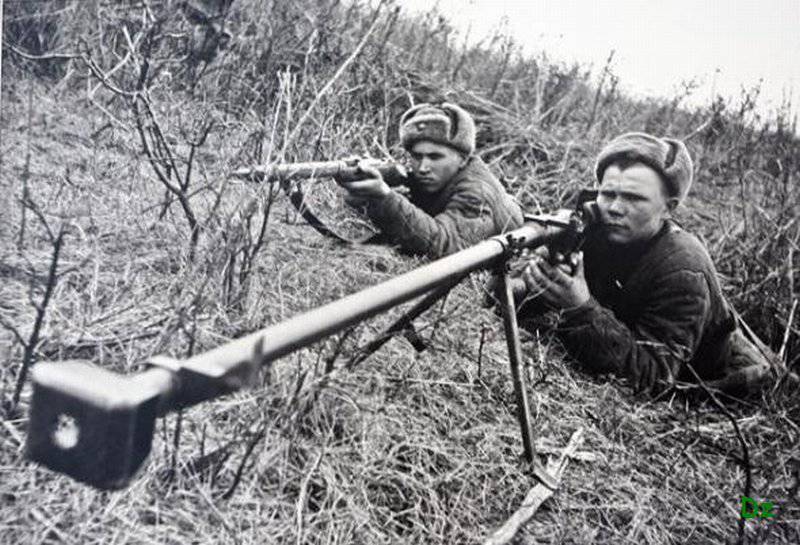
Shortly before the war began, the prevailing opinion in the Soviet military leadership was that in the future war with Germany, our troops would have to deal with significant quantities fired tanks enemy, with a thickness of frontal armor up to 100 mm.
Was this a mistake or a consequence of misinformation, but as a result, the work on creating light anti-tank systems was curtailed, the production of the 45-mm anti-tank gun was discontinued, significant resources were spent on the creation of guns capable of fighting heavy tanks, which the Germans had before the 1943 year in significant quantities did not have.
The result of work on the creation of anti-tank artillery systems with high armor penetration was the adoption of 57-mm guns armament. The 1941 of the Year became known later as the ZIS-2 and 107-mm Divisional Guns of the Model 1940 of the Year (M-60).
The release of these gun systems soon after the start of the war was discontinued. ZIS-2 was re-launched into production in the 1943 year, and M-60 was no longer produced.
As a result, our infantry, in the absence of support in the form of anti-tank artillery, was left to itself when it met enemy tanks, which often led to heavy losses.
The 1935 and 1938 soviet "Manual on Small Cases" provided for the use of bundles of hand grenades of the 1914 / 30 and RGD-33. It was they who became the first and often the only anti-tank weapon of the Red Army.
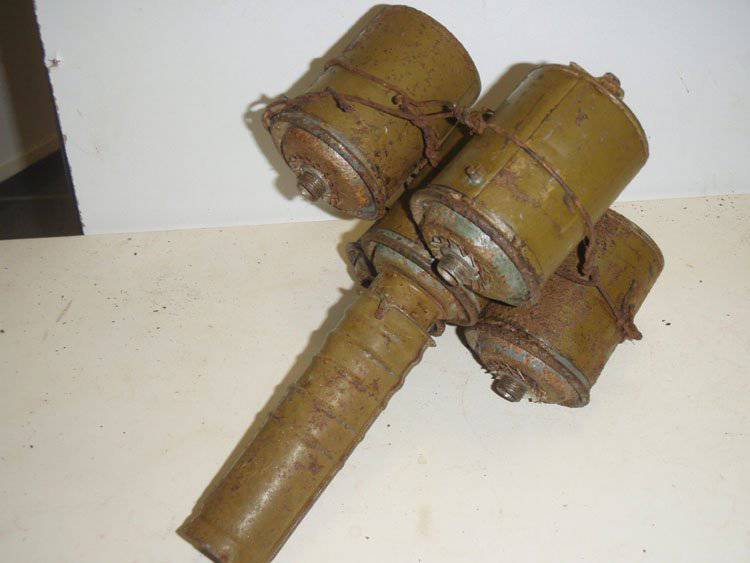
For the manufacture of bundles of grenades obr. 1914 / 30 it was prescribed to use 5 equipped with hand grenades and mounted on a safety platoon. Grenades were tied with string or wire, while four of them turned out to be turned with their arms in one direction, and the fifth - in the middle, in the opposite direction. When throwing a bunch was taken by the handle of an average grenade, located in the middle, it served to undermine the other four, thereby fulfilling the role of a kind of detonator for the whole bunch.
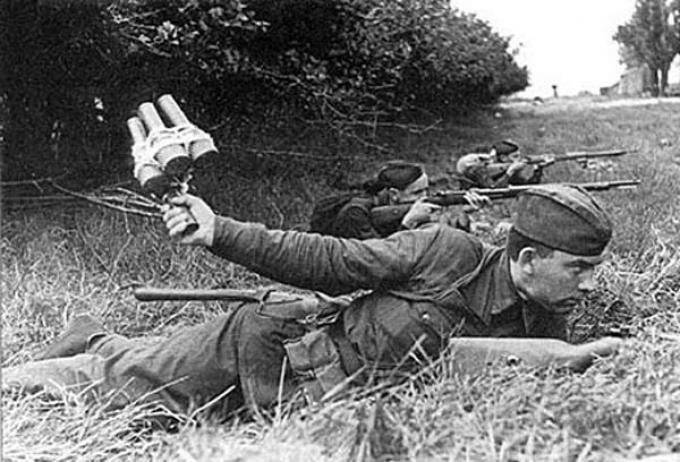
When using RGD-33 grenades, two to four grenades were attached to an average grenade, from which fragmentation shirts were preliminarily removed and the handles were unscrewed. Bundles were recommended to throw from the shelter under the tank tracks.
In 1940, the RPK-40 anti-tank grenade, 1200 gr., Equipped with 760 gr. TNT, with a percussion fuse, created by MI Bubble. However, its production began only with the start of hostilities.
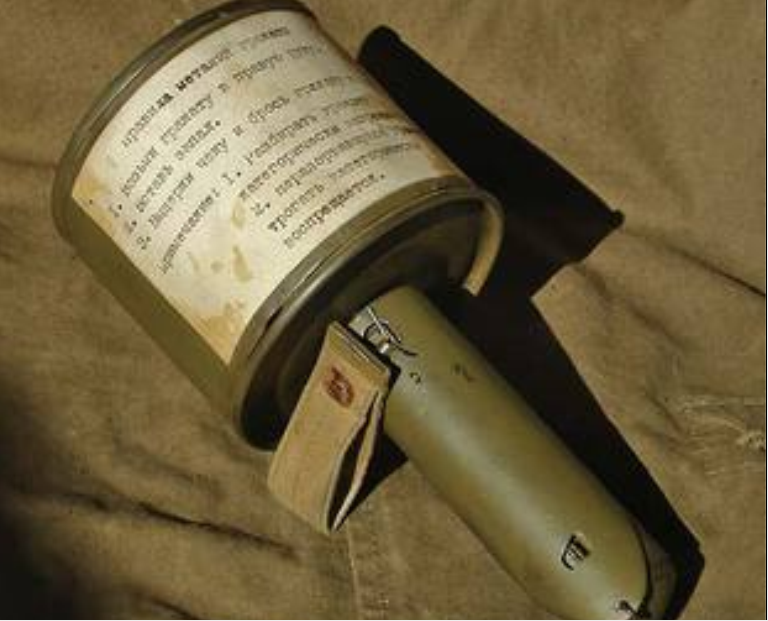
The RPG-40 had a cylindrical thin-walled body, was able to pierce armor with a thickness of up to 20 mm. An inertial instantaneous ignition fuse with a percussion mechanism and a safety check was placed in the handle.
Before the throw, a detonator was inserted into the axial channel of the hull - modeled on the RGD-33 manual fragmentation grenade - through a hole in the lid. On the body was placed instructions for the use of grenades. According to the “armor-piercing” action of the grenade, it soon ceased to meet the requirements of the VET — with an explosion on the surface of armor thicker than 20 mm, it formed only a dent.
In this regard, M.I. Bubble in 1941 year created a more powerful RPG-41 grenade.
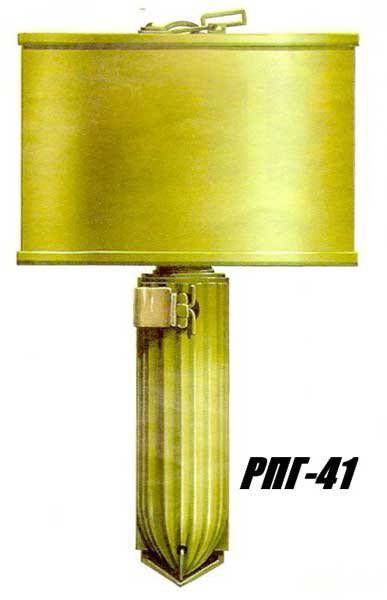
The explosive charge was increased to 1400 gr., Which increased the armor penetration by 5 mm. However, the growth of the mass of the grenade led to a decrease in the range of its throw.
High-explosive anti-tank grenades, as well as bunches of grenades, presented a great danger to those who used them. Their relative safe use was possible only from a trench or other shelter. All this, as well as low armor penetration, led to the development of cumulative anti-tank grenades.
In the middle of 1943, a fundamentally new grenade of cumulative action RPG-43, developed by N.P. Belyakov. It was the first cumulative hand grenade developed in the USSR.
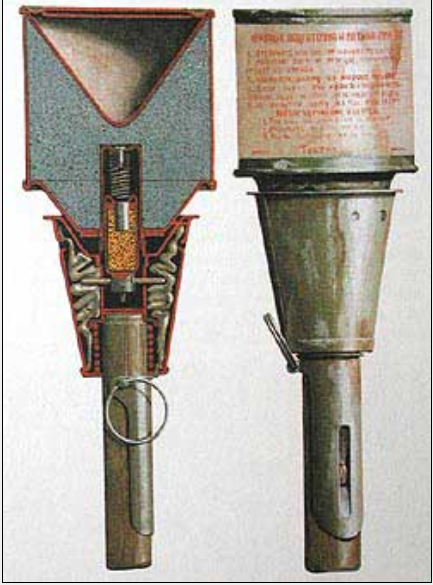
The RPG-43 had a body with a flat bottom and a conical lid, a wooden handle with a safety mechanism, a ribbon stabilizer and a shock-igniting mechanism with a fuse. Inside the case there is a bursting charge with a cumulative notch of conical shape, lined with a thin layer of metal, and a cup with a safety spring fixed in its bottom and a sting.
At its front end of the handle there is a metal sleeve inside which the holder is located and the pin holding it in the rearmost position. Outside, a spring is put on the sleeve and fabric tapes are fastened to the stabilizer cap. The safety mechanism consists of a flap and checks. A folding bar serves to hold the stabilizer cap on the grenade handle until it is thrown, not allowing it to crawl or turn in place.
During the throw of the grenade, the flap is separated and releases the stabilizer cap, which, under the action of a spring, slides off the handle and pulls the tapes behind it. The safety stud falls out under its own weight, freeing the holder of the fuse. Due to the presence of the stabilizer, the flight of the grenade took place head-first, which is necessary for the optimal use of the energy of the cumulative charge of the grenade. When a grenade strikes a barrier with a bottom of the body, the igniter, overcoming the resistance of the safety spring, imposes a sting detonator on the sting, which causes a bursting charge to explode. The cumulative RPG-43 charge punched armor with a thickness of up to 75 mm.
With the advent of German heavy tanks on the battlefield, a hand-held anti-tank grenade was needed with greater armor penetration. A group of designers consisting of M.Z. Polevanova, L.B. Ioffe and N.S. Zhitkikh has developed a cumulative RPG-6 grenade.
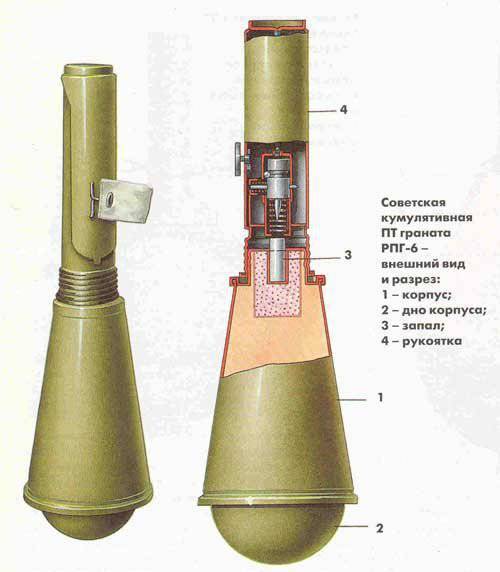
In October, 1943, the grenade was adopted by the Red Army. The RPG-6 grenade largely repeated the German PWM-1 German anti-tank hand grenade.
The RPG-6 had a drop-shaped body with a charge and an additional detonator and a handle with an inertial fuse, a primer-detonator and a ribbon stabilizer.
Drummer fuse blocked check. The tapes of the stabilizer were laid in the handle and held by the safety bar. The safety pin was removed before the throw. After the throw, the safety bar flew off, the stabilizer was pulled out, the drummer's check was pulled out - the fuse was set.
Thus, the protection system RPG-6 was a three-stage (the RPG-43 - two-stage). In terms of technology, a significant feature of the 6 RLG was the absence of chiseled and threaded parts, the extensive use of stamping and knurling. Compared with the RPG-43, the RPG-6 was more technological in production and somewhat safer to handle. RPG-43 and RPG-6 on 15-20 were rushing in m, after the throw the fighter should have taken refuge.
No less common anti-tank Soviet infantry were incendiary bottles.
It is inexpensive, easy to use and very effective. weapon It became widely known during the years of the Spanish Civil War, where it was first used by the rebels of General Franco against republican tanks.
Later, bottles of fuel were used against the Soviet tanks during the Winter War by the Finns, who called them the "Molotov Cocktail". In the Red Army, they became the Molotov Cocktail.
Initially, these were handicrafts filled with troops with flammable liquids (gasoline or kerosene) glass beer or vodka bottles with a stopper fuse made from tow. Before you throw the bottle at the target, the fuse should be ignited.
When it hits the target, the glass breaks, the flammable liquid spreads and ignites from the fuse. As a thickener, rosin, tar or coal tar were often added to make the flammable liquid sticky and slow down the burning.
Contact with the engine compartment of the tank or armored vehicle of the bottle and leaking of burning liquid inside, usually led to a fire. The burning liquid on the tank’s frontal armor, as a rule, did not set it on fire, but prevented observation, aimed fire, and had a strong moral and psychological effect on the crew.
Soon the production of "fireblocks" was established on an industrial scale. 7 July 1941, the State Defense Committee issued a decree “On anti-tank incendiary grenades (bottles)”, which obliged the Narkomisheprom to organize with 10 July 1941, to equip glass bottles with a mixture according to a specific recipe.
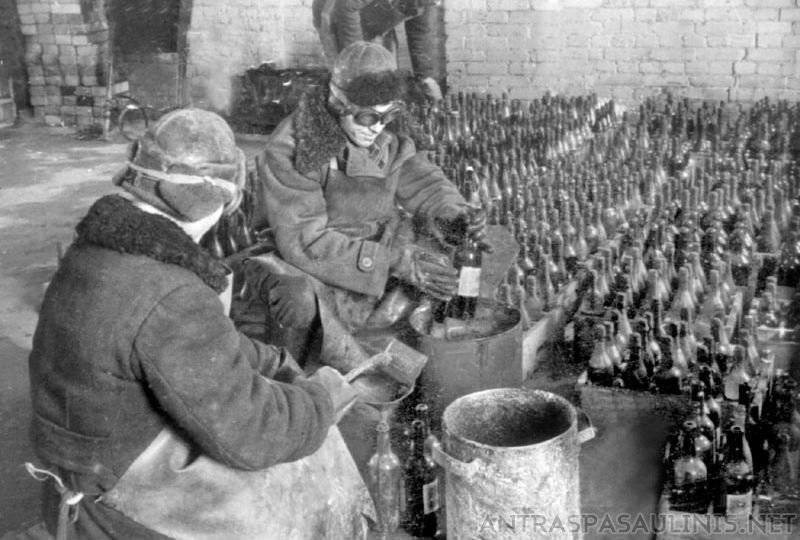
In August, the 1941 of the year was developed and launched into production of an easy-to-use incendiary version. The combustible mixture itself consisted of gasoline, kerosene and ligroin, ignited with the help of a chemical fuse consisting of several glass ampoules with sulfuric acid, potassium chloride and powdered sugar. Which were attached to the sides of the bottle, and ignited when broken, igniting a flammable liquid.
Tula gunsmiths developed and introduced into production (in semi-handicraft conditions of the front line, when almost all equipment was evacuated to the rear) a bottle fuse consisting of 4 pieces of wire, an iron tube with cuts, springs, two ropes and a blank cartridge from a TT pistol . The handling of the igniter was similar to the handling of the ignition for hand grenades, with the difference that the “bottle” igniter only worked when the bottle was broken.
At the same time, other fire mixture formulations were developed and produced.
Chemists A. Kachugin and P. Solodovnikov were able to create, on the basis of a phosphorus solution in carbon disulfide, a self-inflammable CS liquid having a good incendiary ability in combination with an optimal burning time.
In addition to “KS”, several more combustible mixtures were created, known as No. 1 and No. 3. These fire mixtures had a lower burning temperature, but they were much cheaper and easier to equip, they better adhered to the metal and emit more dense smoke when burning. As the fuses in bottles with alternative fire mixtures, small ampoules with liquid CS were used. When it hit the target, the bottle broke, the mixture poured out, and the destruction of the ampoule-igniter caused the “KS” to ignite and, as a result, to ignite all the leaked fuel.
Chemist K.M. Saldadze developed a flammable liquid BGS, which was also used to equip bottles.
Anti-tank grenades and bottles with a combustible mixture were used, which is called "point-blank", when enemy tanks were at a throw distance from their positions.
At the beginning of the war, a special rifle mortar-bottle-bottle appeared for firing (with the help of a wooden wad and a blank cartridge) incendiary bottles. Bottles were taken with a thicker and more durable glass. The target range of throwing the bottle with such a mortar was 80 m, the maximum - 180 m, the rate of fire when calculating the 2 of a person - 6-8 rds / min. Under Moscow, the rifle department was usually given two such mortars, the platoon had 6-8 mortars.
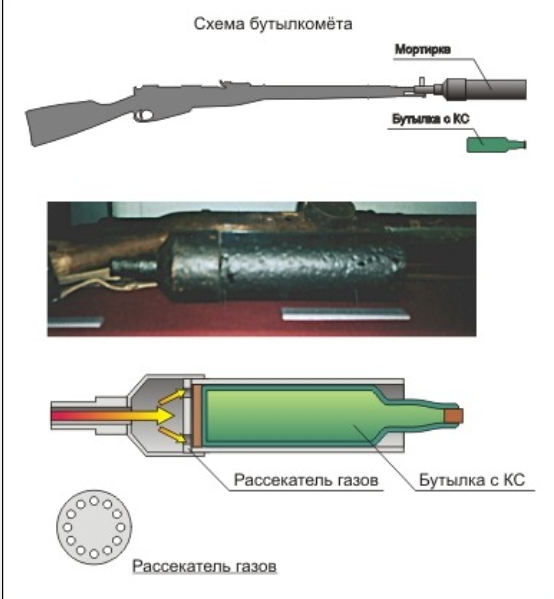
Shooting was carried out with the emphasis of the butt into the ground. Accuracy was low, and the bottles were often broken when fired, so the bottle was not widely used.
In service with the Red Army in the 1920-1930-ies consisted muzzle-loading "Dyakonov grenade launcher", created at the end of the First World War and subsequently modernized.
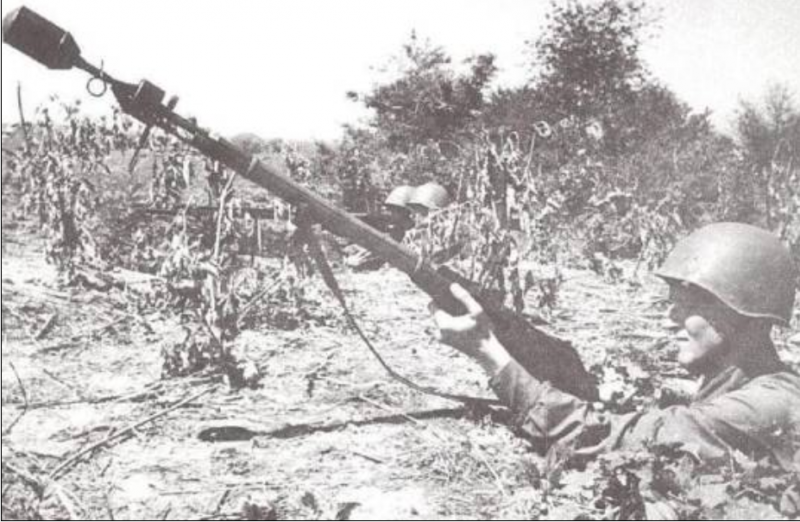
He was a mortar of 41-mm caliber, which was put on the rifle barrel, fixing on the front sight. On the eve of World War II there was a grenade launcher in each rifle and cavalry unit. At the same time, the question arose of giving the "anti-tank" properties to the rifle grenade launcher.
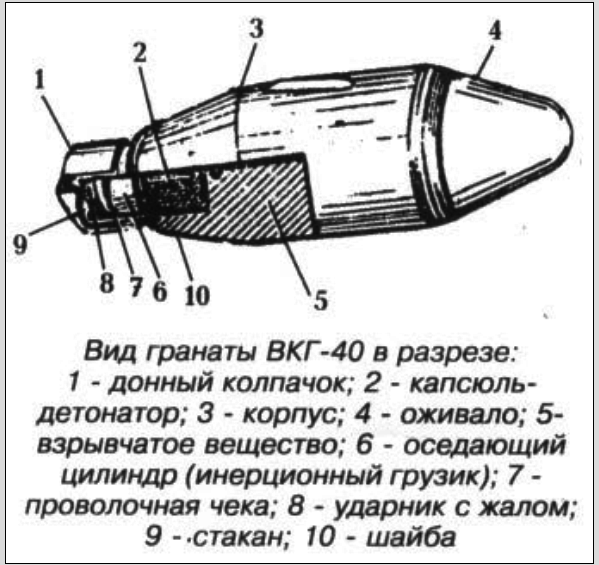
Unfortunately, the development of anti-tank cumulative grenades was delayed. Grenade VKG-40 entered service only in 1944 year. The reduced charge of the blank cartridge allowed firing with a grenade direct fire with emphasis on the butt in the shoulder, at a distance of up to 150 meters.
Normal armor penetration was 45-50-mm armor, which for that time was not enough. Used VKG-40 is very limited, due to the low accuracy of fire and poor armor penetration.
Antitank rifles (PTR) turned out to be much more common weapons. Their design in the USSR began more 30-s. Of the pre-war developments, the most successful was the one developed by N.V. Rukavishnikov under 14.5-mm cartridge self-loading rifle, with a rate of fire to 15 shots / min. In August, 1939, it successfully passed the tests, and in October it was commissioned under the designation PTR-39. But mass production was not adjusted.
The reason for this was the incorrect assessment of the new weapon by the leadership of the People's Commissariat of Defense and, above all, the head of the State Agrarian University Kulik. According to G. I. Kulik, in the German army armored forces were re-equipped with tanks with thickened armor. Because of the incorrect assessment of German armored vehicles, it was believed that not only anti-tank guns, but even some types of artillery guns were powerless in front of them.
The war immediately showed the fallacy of this decision. The Soviet infantry was deprived of effective PT melee weapons. An attempt to establish at the beginning of the war a massive release of Rukavishnikov’s guns was not crowned with success. Finishing and putting it on production would require a lot of time.
As a temporary measure in July 1941, at the suggestion of engineer V.N. Sholokhov in the workshops MVTU them. Bauman established the assembly of a single-shot PTR for 12,7-mm cartridge DShK.
A simple design was copied from the German Mauser PTR of the First World War with the addition of a muzzle brake, a shock absorber on the butt and the installation of light folding bipods. For firing from it were used cartridges with armor-piercing incendiary bullets of B-32 mass 49 gr. with a hardened steel core and BS-41 armor-piercing incendiary bullets weighing 54 gr. with a tungsten alloy core.
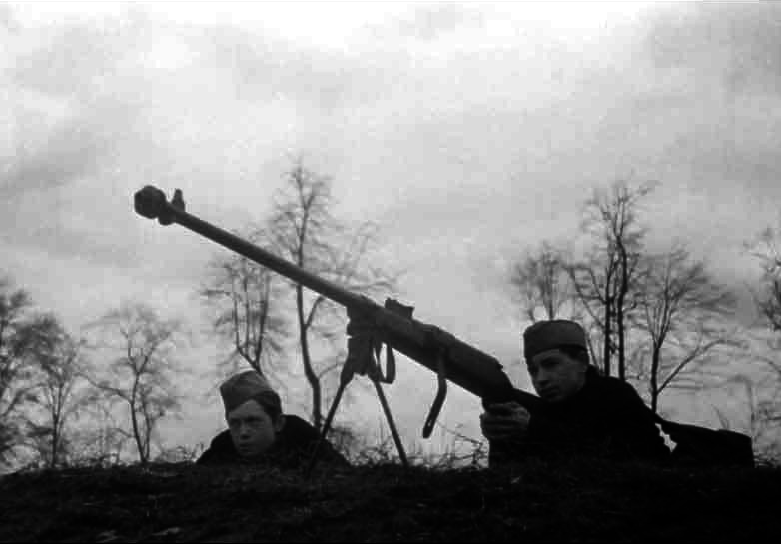
Penetration from 300 to 20-mm armor. The 12,7-mm anti-tank rifles were significantly inferior in performance to the 14,5-mm weapons and by the beginning of 1942, they were out of production.
At one of the meetings of the GKO I.V. Stalin proposed to speed up work on an efficient and technologically advanced 14,5-mm PTR to entrust the development to "one more, and for reliability - to two designers." The assignment was issued on July 1941, V.A. Degtyarevu and S.G. Simonov. A month later, ready-to-test constructions appeared - the entire 22 day passed from the moment of receiving the assignment to the first test shots.
August 29 1941, after the demonstration to the members of the State Defense Committee, the self-loading model Simonov and the single-shot Degtyarev were adopted under the designation PTRS and PTRD.
New anti-tank guns were supposed to fight with light and medium tanks, as well as with armored vehicles at a distance of up to 500 meters.
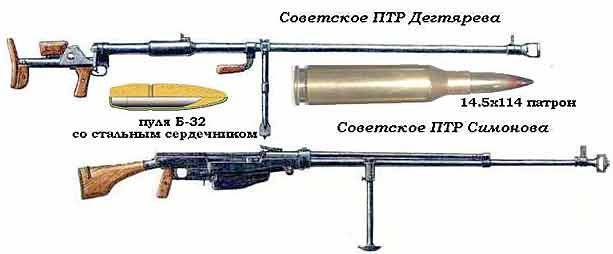
The single-shot anti-tank gun Degtyarev was easier, cheaper and easier to manufacture. The minimum of parts, the use of the butt tube instead of the frame, greatly simplified the production of anti-tank guns, and the automatic opening of the shutter increased the rate of fire. To compensate for the powerful recoil, the PTDD had a highly efficient muzzle brake, and a soft pad on the butt.
Degtyarev's anti-tank rifle successfully combined simplicity, efficiency and reliability. The speed of production production was of great importance in those conditions. The first batch in the 300 units of the PTDD was completed in October and sent to the army in early November. 16 November they were first used in combat. By December 30 1941 released 17 688 anti-tank guns Degtyarev, and during the 1942 year - 184 800 units.
Simonov's self-loading anti-tank rifle worked according to the automatic scheme with removal of powder gases and had 5 ammunition loading.
In 1941, the entire Simonov 77 anti-tank rifles were launched, in 1942, the number was already 63 308 units. The establishment of mass production made it possible to reduce the cost of weapons - for example, the cost of a Simonov anti-tank gun from the first half of 1942 to the second half of 43 decreased almost twice.
From December 1941, the company of PTR (in 27, and later in 54 guns) was introduced into the rifle regiments. Since the fall of 1942, platoons (18 rifles) of the PTR have entered the battalions. In January 1943, the company of PTR was incorporated into the motorized rifle-machine-gun battalion of the tank brigade. Only in March 1944, when the role of anti-tank guns decreased, did the companies disband. By this time, the front edge of our troops was saturated with a sufficient amount of anti-tank artillery.
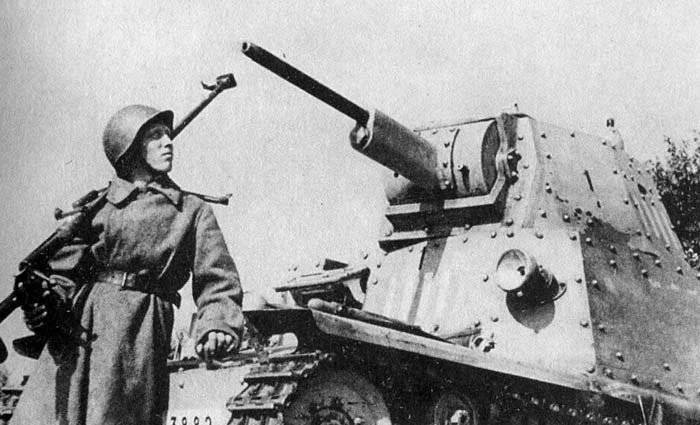
PTRD and PTRS anti-tank guns proved to be very effective anti-tank weapons in the initial period of the war. At a distance of 300 m along the normal, penetration of 35-mm armor was ensured, and at a distance of 100 m 40-mm armor was penetrated. This ensured the penetration of the side armor of the most massive German medium tank PzKpfw IV, which was used throughout the war. Also from the PTR could be fired at the pillboxes / bunkers and firing points, covered with armor, at distances to 800 m and the planes at distances to 500 m, there are known cases of shelling of enemy railway echelons from PTR.
Having played a significant role in anti-tank defense in 1941-1942, anti-tank rifles by the summer of 1943, with the increase in armor protection of tanks, they lost their importance. The largest number of anti-tank guns was transferred to the army in 1942 year - 249 000 units, and in the first half of 1945 year, the total 800 units.
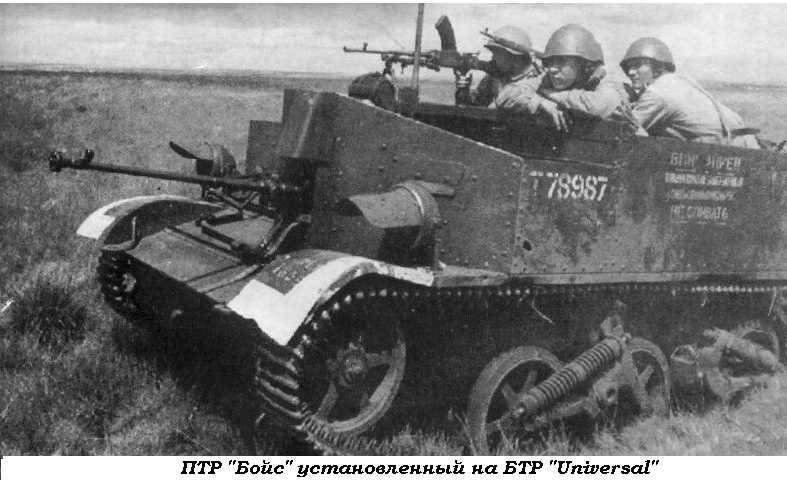
In addition to domestic PTR, the troops had British 13,9-mm “Boyes”, which were significantly inferior in their capabilities to the Soviet PTR.
Anti-tank guns have eliminated the gap between the "anti-tank" capabilities of artillery and infantry. At the same time, it was the front-line weapon, suffered significant losses - during the war 214 thousand anti-tank guns of all models, that is 45,4%, were lost. The largest percentage of losses was observed in 41 and 42 years - 49,7 and 33,7%, respectively.
Losses of the material part corresponded to the level of losses among the personnel. The presence of anti-tank guns in the infantry units allowed them to increase their resistance in the defense and, to a great extent, get rid of the "tank fear".
During the war in the USSR, anti-tank grenade launchers similar to Panzerfaust or Bazuki were never created.
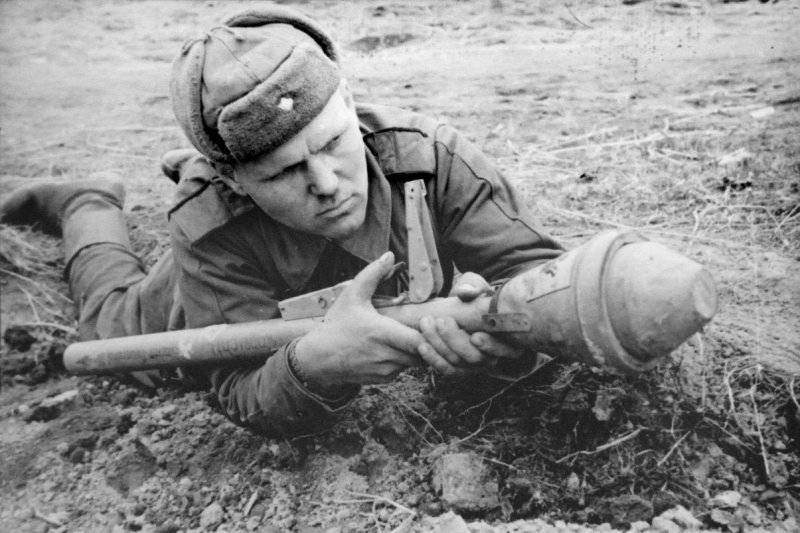
To some extent this was offset by a significant number of captured German grenade launchers, which at the final stage of the war were very widely used by our infantry.
Based on:
http://vadimvswar.narod.ru/ALL_OUT/TiVOut0204/InPTO/InPTO021.htm
http://guns.arsenalnoe.ru/m/4779
The magazine "Equipment and weapons" Semen Fedoseev "Infantry against tanks"
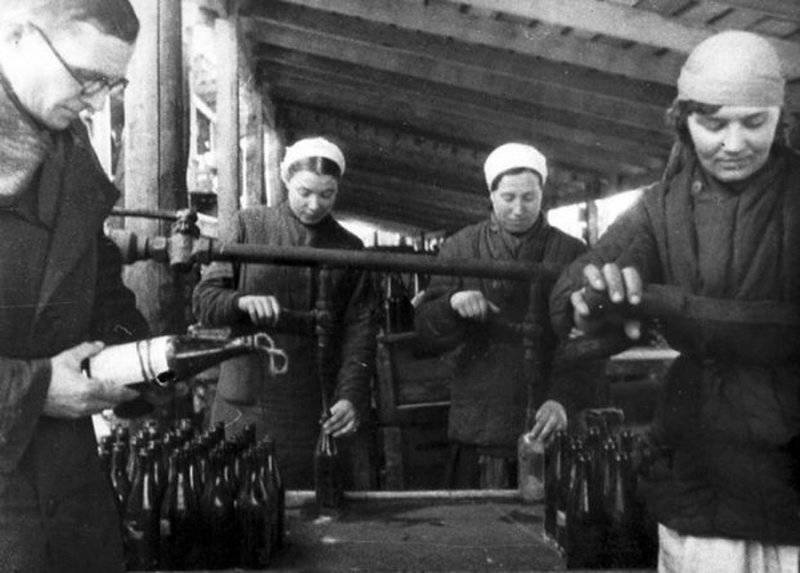
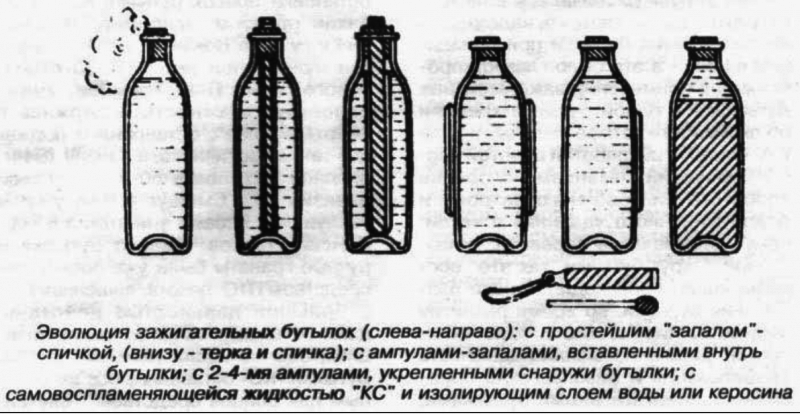

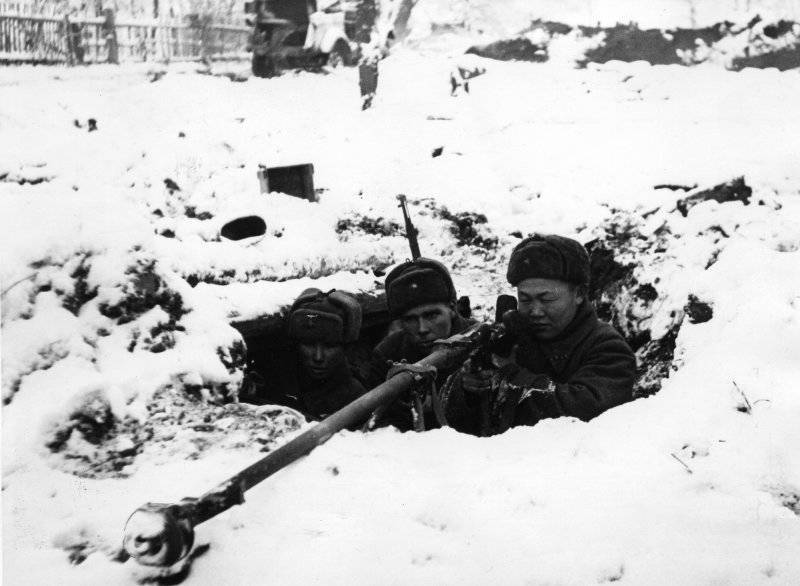
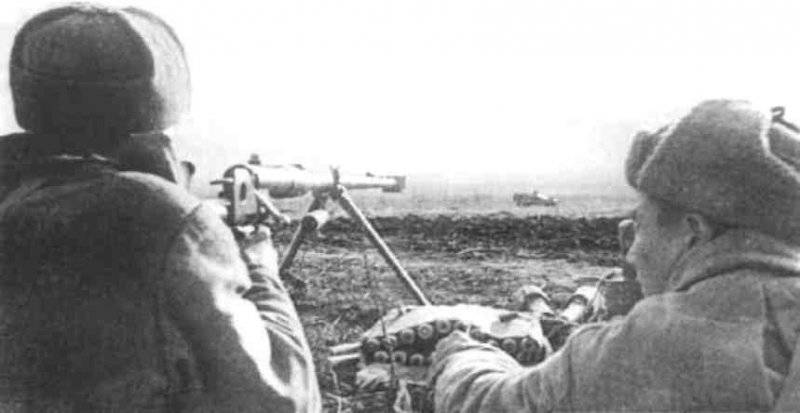
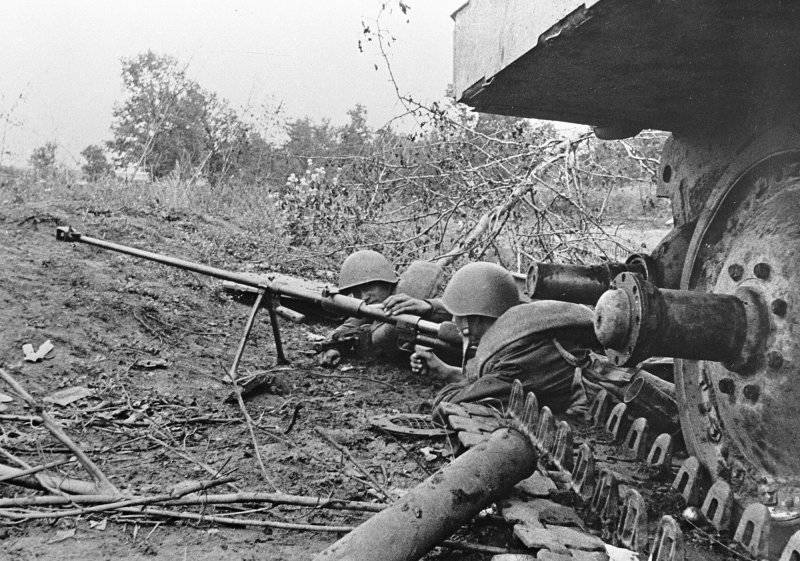
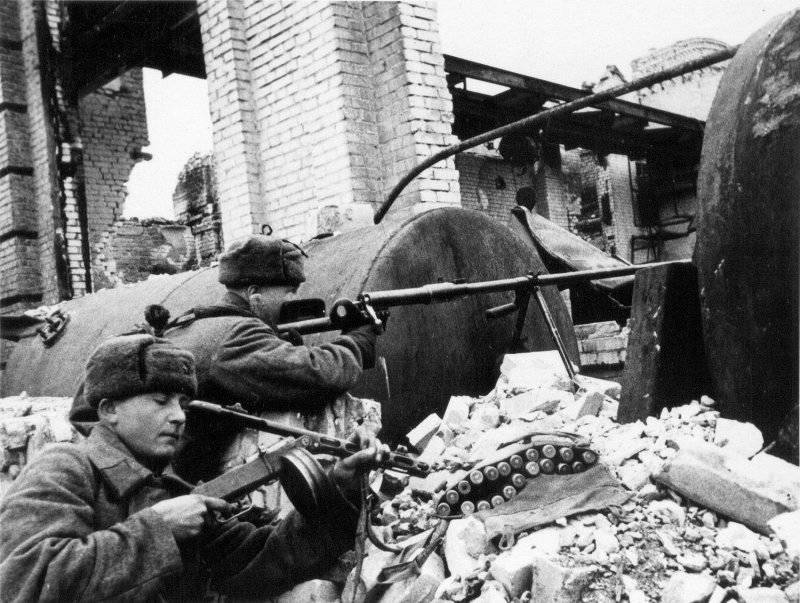
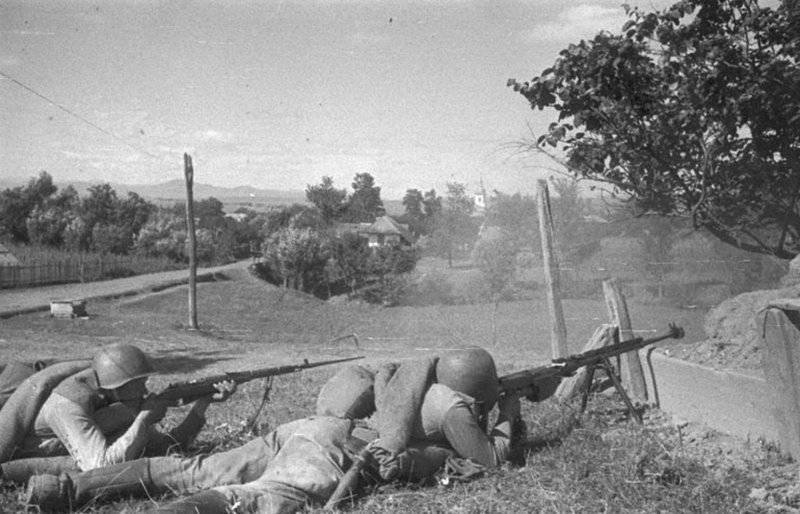
Information